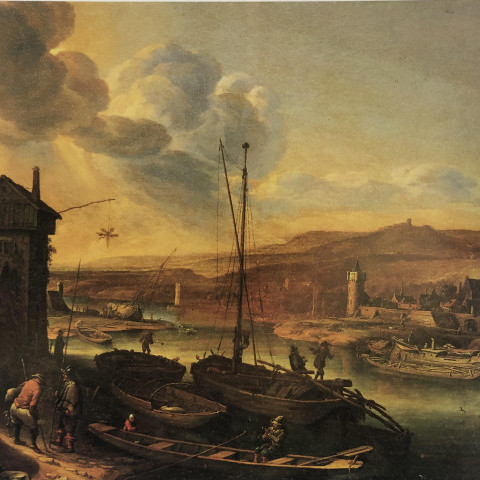Herman Saftleven was a painter, draughtsman and engraver and the brother of Cornelis Saftleven. He settled in Utrecht in 1632 and in 1633 married Anna van Vliet. They had two sons, Dirck Saftleven and Herman Saftleven III, as well as two daughters, Sara (who married Jacob Adriaensz. Broers in 1671) and Levina (who married Paul Dalbach).
From 1639 onwards Herman Saftleven II lived in Utrecht, and in 1659 he became a citizen of the city. He recorded views of his adopted city in several drawings and etchings. He several times served as head man (overman) and dean of the Guild of St Luke there. In 1662 he arranged the sale of part of the Earl of Arundel's collection in Utrecht. A hurricane destroyed the city in 1674, and Saftleven drew many devastated houses and streets. Some eight years later, c. 1682, he sold the city a series of 22 drawings he had made of Utrecht churches before they were destroyed. About this same time (1680 and 1682-4) he was commissioned by the amateur botanist and horticulturalist Agnes Block (1629-1704) to draw flowers and plants at Vijverhof, her country estate situated on the River Vecht, near Utrecht.
There are over 300 paintings by Herman Saftleven II, produced between 1630 and 1684, all of them probably originally bearing monograms or signatures. His early work is indebted to Pieter de Molijn and Jan van Goyen; he subsequently fell briefly under the influence of Abraham Bloemaert and that of Jan Both. His subjects include farmhouse interiors, imaginary riverscapes and Italianate landscapes.
At the time of his brief collaboration with his brother Cornelis, from c. 1633, he produced a number of rustic barn interiors. These he continued to paint until 1637, and they were superior to similar subjects by his brother. Herman's genre paintings have been mistaken for works by Pieter de Bloot, Frans Rijckhals and Hendrick Sorgh.
In 1635 Herman collaborated on the painted decoration of Prince Frederick Henry's palace of Honselaersdijck, south of The Hague. From about that time Herman began painting Italianate landscapes in the style of Cornelis van Poelenburch. Other biblical subjects include works dated 1642, 1648 and 1667 (Jesus Preaching at Lake Gennesaret; London, National Gallery). He also painted mountainscapes in the style of Roelandt Savery and wooded landscapes in the style of Alexander Keirinckx and Jan Both. By about 1645, however, Saftleven abandoned Italianate subjects in favour of native 'Dutch' landscapes, a change probably stimulated by a visit in 1644 to the eastern Dutch province of Gelderland. From 1650 onwards he concentrated on imaginary Rhineland views and on topographically accurate hilly and rocky landscapes, peopled with tiny figures.
More than 1200 topographical and imaginary landscape drawings have survived, most of them bearing monograms and about 200 of them dates. The drawings are not rough sketches, but for the most part finished, often large-scale, drawings made for collectors, such as 37 sheets made for the Atlas van der Hem (Vienna, Österreichische Nationalbibliothek) assembled c. 1663-6 by the Amsterdam lawyer Laurens van der Hem. As well as the drawings of Utrecht, there are another 60 of other views in the Netherlands and around 50 from the Lower and Middle Rhine regions of Germany (e.g. of castles). In 1651 Herman made a second visit to the eastern Netherlands, to Arnhem and Cleve (now Kleve, Germany), whence he proceeded up the Rhine to Bingen. In 1677 he produced an integrated series of imaginary Rhineland views. His imaginary landscapes and drawings of animals reflect the influence of Roelandt Savery. His drawings and watercolours of plants made for Agnes Block are among the most impressive botanical studies in 17th-century Dutch art.
Herman II was also very active as a printmaker and produced an extensive oeuvre of etchings and engravings. The earliest etchings date from 1627 and show the influence of Willem Buytewech. Saftleven completed a series of landscape etchings c. 1640, and by c. 1644 he was making Italianate etchings in the style of Jan Both. Jan van Almeloveen and Jan van Aken, who may have worked directly for Saftleven at times, emulated his landscape prints. During his lifetime, Saftleven's paintings of imaginary river views and drawings of realistic landscapes made him one of the best-known Dutch artists.
Saftleven's pupils included from c. 1645 the landscape painter Jan Gerritsz. van Bemmel and his brother Willem van Bemmel and from 1668 to 1671 Jan van Bunnick. Within a few years of his death, and especially in the 18th and 19th centuries, his paintings were much sought after and also frequently copied, for example by Jan Griffier I, whose copies were often mistaken for originals, and by Griffier's sons Robert and Jan II. Saftleven also influenced several 18th-century German painters, including Johann Christian Vollerdt, Christian Hilfgott Brand, Johann Christian Brand, Christian Georg Schütz and the latter's nephew, Christian Georg Schütz II.
Collections
Saftleven is represented in the following collections: Rijksmuseum, Amsterdam; Teyler Museum, Haarlem; Museum Bredius, Netherlands; National Gallery, London; Courtauld Institute of Art, London; Dulwich Picture Gallery, London; Albertina Museum, Vienna; Kunsthistorisches Museum, Vienna; Kupferstichkabinett, Berlin; Kunsthalle, Weimar; Museum der Bildenden Künste, Leipzig; Hermitage Museum, Saint Petersburg; J. Paul Getty Museum, Los Angeles; Fine Arts Museums of San Francisco; Österreichische Nationalbibliothek, Vienna; Museum of Fine Arts, Boston, amongst others.
Source: askart.com

